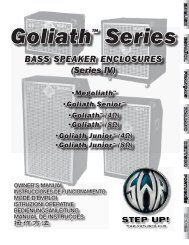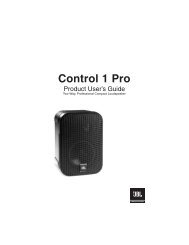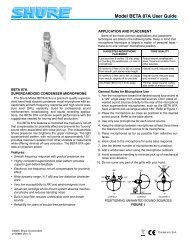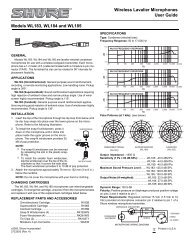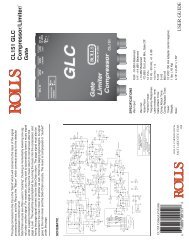SRM150 Compact Active PA System User's Manual - Pro Music
SRM150 Compact Active PA System User's Manual - Pro Music
SRM150 Compact Active PA System User's Manual - Pro Music
Create successful ePaper yourself
Turn your PDF publications into a flip-book with our unique Google optimized e-Paper software.
SERVICE INFORMATION<br />
If you think your Mackie product has a problem,<br />
please check out the following troubleshooting tips and<br />
do your best to confirm the problem. Visit the Support<br />
section of our website (www.mackie.com/support)<br />
where you will find lots of useful information such as<br />
FAQs and other documentation. You may find the answer<br />
to the problem without having to send your Mackie<br />
product away.<br />
<br />
No power!<br />
• Our favorite question: Is it plugged in Make sure the<br />
AC outlet is live (check with a tester or lamp).<br />
• Our next favorite question: Is the POWER switch on If<br />
not, try turning it on.<br />
• Is the blue light on the front panel illuminated If not,<br />
make sure the AC outlet is live. If so, refer to “No sound”<br />
below.<br />
• The resettable circuit breaker has popped. Refer to<br />
“FUSE” [9] on page 10 for information on the circuit<br />
breaker.<br />
No sound!<br />
• Is the input gain control [3] or the MAIN LEVEL [6]<br />
control turned all the way down Follow the procedures<br />
in the “Quick Start” section on page 4 to verify that all<br />
the volume controls in the system are properly adjusted.<br />
• Is the signal source working (and making union scale)<br />
Make sure the connecting cables are in good repair and<br />
securely connected at both ends. Make sure the output<br />
volume (gain) control on whatever is connected to the<br />
<strong>SRM150</strong> is turned up sufficiently to drive the inputs of<br />
the speaker.<br />
Bad sound!<br />
• Is it loud and distorted Follow the procedures described<br />
in the “Quick Start” section to verify that the<br />
levels are set properly.<br />
• Is the input connector plugged completely into the<br />
jack Be sure all connections are secure. It’s a good<br />
idea to periodically clean all electrical connections with<br />
a non-lubricating electrical contact cleaner.<br />
Noise<br />
• Make sure all connections to the active speakers are<br />
good.<br />
• Make sure none of the signal cables are routed near<br />
AC cables, power transformers, or other EMI-inducing<br />
devices.<br />
• Is there a light dimmer or other SCR-based device on<br />
the same AC circuit as the <strong>SRM150</strong> Use an AC line<br />
filter or plug the <strong>SRM150</strong> into a different AC circuit.<br />
Hum<br />
• Turn the MAIN LEVEL control all the way down. If the<br />
noise disappears, it’s coming from the signal source. If<br />
not, try disconnecting the cables connected to the input<br />
jacks one at a time. If the noise disappears, it could be a<br />
“ground loop,” rather than a problem with the <strong>SRM150</strong>.<br />
Try some of the following troubleshooting ideas:<br />
• Use balanced connections throughout your system for<br />
the best noise rejection.<br />
• Whenever possible, plug all the audio equipment’s linecords<br />
into outlets which share a common ground. The<br />
distance between the outlets and the common ground<br />
should be as short as possible.<br />
Never remove the ground pin on the<br />
power cord of the <strong>SRM150</strong> or any other<br />
component. This is very dangerous.<br />
14


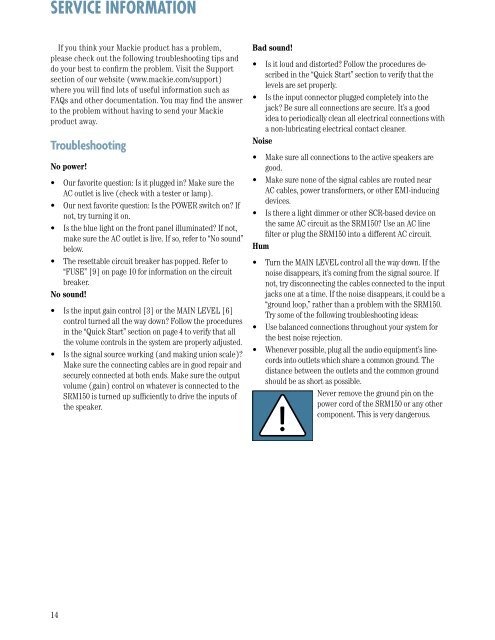
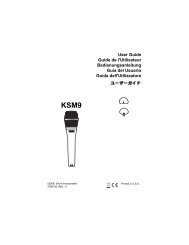
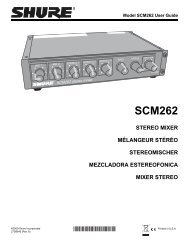

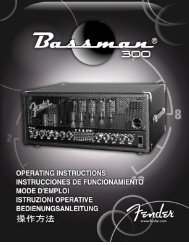
![2 Use the CATEGORY [DEC] / [INC] but - Pro Music](https://img.yumpu.com/43682164/1/190x245/2-use-the-category-dec-inc-but-pro-music.jpg?quality=85)

